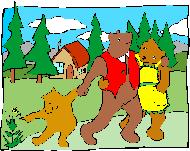I have another goodie for you! Alvina Lopez has written a beautiful post for us on how fairy tales can teach us the value of money! Great job Alvina! Enjoy!
Cheers…Amanda…Excited Life Enthusiast! ;o)
=============================================================
Three Fairy Tales That Can Teach Your Children the Value of Money
written by Alvina Lopez
As Amanda shows us in her Teaching Children About Money Homestudy Course, stories are a great way to teach your children about money. Fairy tales, which are old tales with fantastical elements, are usually taught to children to teach them basic lessons in morality but some of them can be used to teach about financial responsibility as well! While none of the animals or princesses in these tales have credit cards or savings accounts, their decisions and their consequences can help your children understand the value of money.
The Story: A familiar tale that has been in print since the 1860s, The Three Little Pigs follows a Big Bad Wolf as he blows down the First Little Pig’s house of straw, then the Second Little Pig’s house of twigs, and then finally meets his match when he is unable to blow down the Third Little Pig’s house made of bricks.
The Lesson: The houses of straw and twigs were far cheaper and easier to build, but the house of bricks—which would require more money, time and investment—ended up being worth it in the end. Children can learn from this story that they should spend money on something of good quality that can last a long time.
The Story: Collected by the Brothers Grimm and well-known since the nineteenth century, Rumplestiltskin is the tale of a princess forced with the impossible task of spinning straw into gold. A little gnome named Rumplestiltskin appears with the solution: he’ll spin the straw into gold for her, first in exchange for her necklace; then in exchange for a ring; and finally, in exchange for her first born. When the princess has her first child years later, Rumplestiltskin comes to collect. The only way the princess can keep her baby is if she can guess her debtor’s name in three days.
The Lesson: Debts must be paid. When I was a child, Rumplestiltskin terrified me because he was so creepy and demanding. In my experiences as an adult, I’ve come to realize that many debt collectors and loan sharks are as well. Faced with a desperate situation, the princess agreed to anything, and this is how many people land themselves in debt in the real world. One thing that children can take away from this fairy tale is that you shouldn’t promise to pay something you’re unable to afford. While no debt collection agency will ask for your children, guessing their name in three days will not clear your credit score or get them to go away.
Goldilocks and the Three Bears
The Story: A little girl named Goldilocks wanders into a cottage and sits in the chairs, eats the porridge and lies in the beds of the cottage’s inhabitants, Papa Bear, Mama Bear and the Baby Bear. Goldilocks finds that Papa Bear’s belongings are too harsh, while the Mama Bear’s things are too gentle for her. Baby Bear’s chair, porridge and bed are “just right” and Goldilocks is caught sleeping in it when the Bears return. Endings vary: in one, Goldilocks runs away from the bears and into the forest, while in another she apologizes for her actions and vows to be more obedient.
The Lesson: Yes, Goldilocks’ tale undoubtedly teaches children to respect other people’s property and possessions. At the very least, Goldilocks has learned that in order to enjoy material goods, they must belong to her first. From this, children can learn that it is only through earning and having money that they can acquire possessions.
Additionally, this tale teaches children the value of shopping around. Goldilocks didn’t settle for a chair, bowl of porridge or bed to sleep in until she found one that best suited her needs. In the real world, children can approach this by carefully shopping rather than buying the first toy or book they see at the store. Because money is valuable, it’s important to learn about the many different offerings in order to get the best deal. Nevertheless, it is still vital to let kids know that looking for the best thing to buy should not involve trespassing or breaking the law!
What other classic fairy tales or fables can you think of that can help children understand money management?
By-line:
Alvina Lopez is a freelance writer and blog junkie, who blogs about accredited online degrees.
Click Here For Some Great Fairy Tales for Your Child that Teach the Value of Money:
(Click on the books to take a “sneak peek” inside them!)
 |
 |
 |
 |

 Comments
Comments Posts
Posts







2 Responses to Guest Post: Three Fairy Tales That Can Teach Your Children the Value of Money